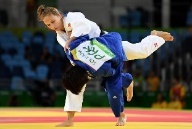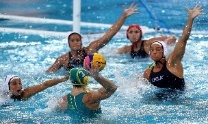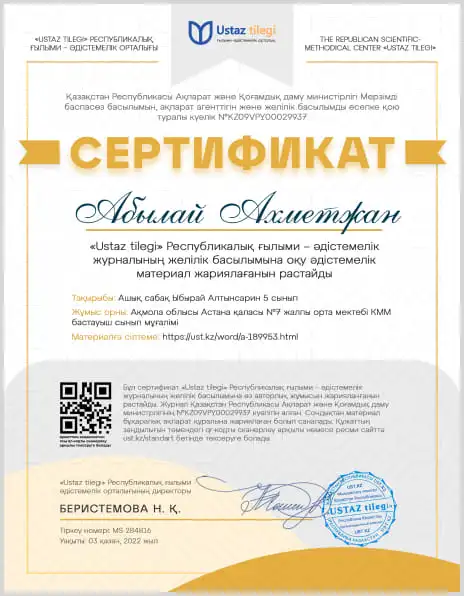MODULE 5
Lesson plan
|
LESSON: Module 5 Lesson 1 |
School: |
||||
|
Date: |
Teacher name: |
||||
|
CLASS: |
Number present: |
absent: |
|||
|
Learning objectives(s) that this lesson |
S6 S7 R3 |
||||
|
Lesson |
All learners will be able to: |
||||
|
identify some specific information in the |
|||||
|
Most learners will be able to: |
|||||
|
identify most specific information in the |
|||||
|
Some learners will be able to: |
|||||
|
identify all specific information in the |
|||||
|
Previous learning |
animal body parts / human facial |
||||
|
Plan |
|||||
|
Planned timings |
Planned activities |
Excel |
Teacher |
||
|
Beginning the lesson S7 |
What’s in this module? Read the title of the module Creativity and ask Ss to suggest what they think it means. Go through the topic To present some mythical creatures · · Elicit the L1 equivalents from Ss around the class. |
Class CD |
|||
|
Main Activities S7 S6 R3 R3 |
To present new vocabulary Go through the features in the list and To relate mythical creatures to Elicit which creatures look like the To describe mythical creatures Read out the example and ask various Ss |
||||||
|
To introduce the topic and predict · Read the title aloud and allow Ss one minute to read the introduction · Ss listen and follow the text in their books and find out the · Play the video for the Ss and elicit their comments at the end. To read for specific · Allow Ss some time to read the text again and mark the sentences T · Direct Ss to the Word List to look up the meanings of the words in |
Video |
||||||
|
Ending the lesson |
Check Ss’ answers. As an extension ask Ss |
||||||
|
Additional information |
|||||||
|
Differentiation – how do you plan to |
Assessment – how are you planning to |
Cross-curricular links |
|||||
|
support less able learners through |
monitor accuracy, use of vocabulary and |
cross-curricular links: Literature |
|||||
|
challenge more able learners through |
|||||||
Lesson plan
|
LESSON: Module 5 Lesson 2 |
School: |
||||
|
Date: |
Teacher name: |
||||
|
CLASS: |
Number present: |
absent: |
|||
|
Learning objectives(s) that this lesson |
S1 S4 S7 C3 C4 W4 |
||||
|
Lesson |
All learners will be able to: |
||||
|
take part in some exchanges using some target language accurately and use some target vocabulary |
|||||
|
Most learners will be able to: |
|||||
|
take part in some exchanges using a range |
|||||
|
Some learners will be able to: |
|||||
|
take part in some exchanges using a range |
|||||
|
Previous learning |
vocabulary for simple film genres/ |
||||
|
Plan |
|||||
|
Planned timings |
Planned activities |
Excel |
Teacher |
||
|
Beginning the lesson S8 S3 |
To consolidate information from a Allow Ss a couple of minutes to review To consolidate information from a · Allow Ss time to write their sentences. In closed pairs, Ss then · Monitor the activity around the class and then ask some pairs to |
||||
|
Main Activities S1 S7 C3 UE5 S4 |
To present types of films · Go through the list of film types and explain/elicit the meanings · Ss complete the task. Check Ss’ answers. Point out that some types |
||||||||
|
To practise agreeing/disagreeing · Explain the task and draw Ss’ attention to the expressions in red · Elicit/Explain that we can use So + auxiliary verb + · Ss talk in pairs about their taste in films. Monitor the activity |
|||||||||
|
Ending the lesson S1 W4 |
To present adjectives and practise · Explain the task and read out the example exchange with a S. · Ss then complete the task in pairs. Monitor the activity around |
||||||||
|
Additional information |
|||||||||
|
Differentiation – how do you plan to |
Assessment – how are you planning to |
Cross-curricular links |
|||||||
|
monitor less able groups in dialogue production |
monitor accuracy and interactional |
cross-curricular links: Literature |
|||||||
|
challenge more able learners to give more |
monitor pronunciation performance in |
||||||||
Lesson plan
|
LESSON: Module 5 Lesson 3 |
School: |
||||
|
Date: |
Teacher name: |
||||
|
CLASS: |
Number present: |
absent: |
|||
|
Learning objectives(s) that this lesson |
S3 S8 S6 UE5 UE9 |
||||
|
Lesson objectives |
All learners will be able to: |
||||
|
use some target structure and pronounce |
|||||
|
Most learners will be able to: |
|||||
|
use a range of target structure including |
|||||
|
Some learners will be able to: |
|||||
|
use a range of target structure including |
|||||
|
Previous learning |
past simple including negative and |
||||
|
Plan |
|||||
|
Planned timings |
Excel |
Teacher |
|||
|
Beginning the lesson UE9 |
To present the past simple of the Explain that was/were is the past |
||||
|
Main Activities UE9 UE5 S3 S8 |
To practise the past simple of the Ss fill in the correct word. Check Ss’ To practise the past simple of the verb ‘to be’ in the negative · Explain the task and read out the example. · Ss complete the task. Check Ss’ answers in the correct word. Check To practise the past simple of the · Draw Ss’ attention to the timetable and then Ss complete the task. · Check Ss’ answers around the class by asking one S to say a |
|||||||
|
To practise talking about the past · Explain the task and read out the example exchange with a S. · Ss then work in pairs and ask and answer. Monitor the activity |
||||||||
|
Ending the lesson UE9 S6 |
To pronounce strong and weak forms · Read out the table and explain that strong and weak forms relate · Play the recording and elicit the strong/weak forms. To consolidate comprehension of Give Ss some time to find examples and |
Class CD |
||||||
|
Additional information |
||||||||
|
Differentiation – how do you plan to |
Assessment – how are you planning to |
Cross-curricular links |
||||||
|
monitor less able groups in controlled |
monitor pair sentence completion tasks |
cross-curricular links: languages |
||||||
|
challenge more able learners to produce |
monitor pronunciation of weak form in |
|||||||
Lesson plan
|
LESSON: Module 5 Lesson 4 |
School: |
||||
|
Date: |
Teacher name: |
||||
|
CLASS: |
Number present: |
absent: |
|||
|
Learning objectives(s) that this lesson |
S4 UE5 UE9 UE13 W4 W7 |
||||
|
Lesson objectives |
All learners will be able to: |
||||
|
use some target structure and pronounce |
|||||
|
Most learners will be able to: |
|||||
|
use a range of target structure including |
|||||
|
Some learners will be able to: |
|||||
|
use a range of target structure including |
|||||
|
Previous learning |
past simple including negative and |
||||
|
Plan |
|||||
|
Planned timings |
Planned activities |
Excel |
Teacher |
||
|
Beginning the lesson |
To present the past simple form of Go through the table and elicit how we |
||||
|
Main Activities UE9 S4 UE13 UE5 S4 UE9 |
To practise the affirmative and · Explain the task and draw Ss’ attention to the picture. · Ss complete the task. Check Ss’ answers. To practise the interrogative form of · Explain the task. Ss work in pairs and ask and answer questions. · Monitor the activity around the class and then ask some pairs to |
||||||
|
To present the past simple form of · Ss read the table. Check Ss’ comprehension by asking various Ss to To practise could in the · Ss complete the task. Check Ss’ answers. |
|||||||
|
To practise could in the · Explain the task. Ss work in pairs and ask and answer using the · Monitor the activity around the class and then ask some pairs to |
|||||||
|
Ending the lesson W4 W7 |
To practise could further using · Explain the task and allow Ss enough time to complete the · Check Ss’ answers by asking various Ss around the class to read |
||||||
|
Additional information |
|||||||
|
Differentiation – how do you plan to |
Assessment – how are you planning to |
Cross-curricular links |
|||||
|
monitor less able learners as they write |
monitor pair sentence completion tasks |
cross-curricular links: languages |
|||||
|
provide challenge to more able learners |
monitor pronunciation of weak form in |
||||||
Lesson plan
|
LESSON: Module 5 Lesson 5 |
School: |
||||
|
Date: |
Teacher name: |
||||
|
CLASS: |
Number present: |
absent: |
|||
|
Learning objectives(s) that this lesson |
C9 S1 S8 |
||||
|
Lesson objectives |
All learners will be able to: |
||||
|
identify some main ideas and detailed |
|||||
|
Most learners will be able to: |
|||||
|
identify most main ideas and detailed |
|||||
|
Some learners will be able to: |
|||||
|
identify all main ideas and detailed |
|||||
|
Previous learning |
vocabulary relating to mythical |
||||
|
Plan |
|||||
|
Planned timings |
Planned activities |
Excel |
Teacher |
||
|
Beginning the lesson C9 |
To introduce the topic and stimulate · Direct Ss’ attention to the picture and ask if they know anything · Play the recording. Ss listen and follow the text in their books |
Class CD |
|||
|
Main Activities R1 R2 R6 S1 S8 S1 L8 |
To read for specific · Allow Ss some time to read the texts and mark the sentences T · Direct Ss to the Word List to look up the meanings of the words in · Check Ss’ answers. Ss should justify their answers. |
||||||
|
To make verb/noun phrases and · Ss match the verbs to the nouns, then ask various Ss around the · Play the video for the Ss and elicit their comments at the end. To practise reading years · Read the Study Skills box aloud and write the examples on the · Direct Ss’ attention to the pictures and ask various Ss around the · Ask various Ss to read out the captions under the pictures. · Choose a pair of Ss to read out the example. · Explain the task and allow Ss time to ask and answer questions · Ask various pairs of Ss to report back to the class about the |
Video |
||||||
|
To listen for specific information · Explain the task and play the recording. Ss listen and complete · Check Ss’ answers. |
|||||||
|
Ending the lesson W4 W6 |
To write a short paragraph Ss complete the paragraph. |
||||||
|
Additional information |
|||||||
|
Differentiation – how do you plan to |
Assessment – how are you planning to |
Cross-curricular links |
|||||
|
monitor less able groups in writing task |
use thumbs up and down technique and |
cross-curricular links: Literature |
|||||
|
provide challenge to more able learners |
|||||||
Lesson plan
|
LESSON: |
School: |
||||
|
Date: |
Teacher name: |
||||
|
CLASS: |
Number present: |
absent: |
|||
|
Learning objectives(s) that this lesson is |
C8 L5 W3 UE9 |
||||
|
Lesson objectives |
All learners will be able to: |
||||
|
use and pronounce some target language |
|||||
|
Most learners will be able to: |
|||||
|
use and pronounce most target structures |
|||||
|
Some learners will be able to: |
|||||
|
use and pronounce most target structures |
|||||
|
Previous learning |
some past simple regular forms |
||||
|
Plan |
|||||
|
Planned timings |
Planned activities |
Excel |
Teacher |
||
|
Beginning the lesson UE9 |
To present the past simple affirmative · Ss close their books. Present the past simple. Say: I worked hard · Explain the spelling rules of the past simple for regular verbs by · Elicit the L1 equivalent for the example. |
||||
|
Main Activities UE9 W3 C8 W3 |
To practise the past simple · Explain the task and allow Ss some time to complete it. · Check Ss’ answers by reading the text aloud and eliciting the To present the past simple negative · Ss close their books. Write on the board: I didn’t work · Ss open their books. Read out the rule and elicit the word to |
||||||||
|
To practise the past simple · Explain the task. Allow Ss two minutes to read the text in Ex. 2 · Ss complete the task. Ask various Ss to read out the answers to |
|||||||||
|
Ending the lesson L5 |
To pronounce · Play the recording with pauses for Ss to listen and repeat · Pay special attention to Ss’ pronunciation and intonation and · Elicit other words with the same sounds from Ss around the class. · Refer Ss to the text in Ex. 2 again and elicit the past forms. |
Class CD |
|||||||
|
Additional information |
|||||||||
|
Differentiation – how do you plan to |
Assessment – how are you planning to |
Cross-curricular links |
|||||||
|
monitor less able groups in controlled |
monitor pair sentence completion tasks |
cross-curricular links: History |
|||||||
|
challenge more able learners to produce |
check pronunciation in whole class |
||||||||
Lesson plan
|
LESSON: Module 5 Lesson 7 |
School: |
||||
|
Date: |
Teacher name: |
||||
|
CLASS: |
Number present: |
absent: |
|||
|
Learning objectives(s) that this lesson |
C8 S4 UE5 UE9 W3 |
||||
|
Lesson objectives |
All learners will be able to: |
||||
|
use some target structure and pronounce |
|||||
|
Most learners will be able to: |
|||||
|
use a range of target structure including |
|||||
|
Some learners will be able to: |
|||||
|
use a range of target structure including |
|||||
|
Previous learning |
past simple including negative and |
||||
|
Plan |
|||||
|
Planned timings |
Planned activities |
Excel |
Teacher |
||
|
Beginning the lesson UE9 UE5 |
To present the past simple interrogative · Ss close their books. Write on the board: Did I play tennis · Ask Ss questions to check their understanding. T: Did you S1:Yes, I T: Did your S2: Yes, · Ss open their books. Read the table aloud and elicit the missing |
||||
|
Main Activities UE9 UE5 S4 UE5 S4 C8 |
To practise using the past simple Allow Ss some time to complete the task To practise using the past simple · Explain the task and read out the example. · Ss do the task. Check Ss’ answers. · Play the video for Ss and elicit their comments at the end. |
Video |
|||||||
|
To practise using the past simple · Explain the task and read out the example exchange. · Ss work in closed pairs and complete the task. Monitor the |
|||||||||
|
Ending the lesson W3 |
To write about past events Allow Ss time to do the task. Then ask |
||||||||
|
Additional |
|||||||||
|
Differentiation – how do you plan to |
Assessment – how are you planning to |
Cross-curricular links |
|||||||
|
monitor less able groups in controlled |
monitor pair sentence completion tasks |
cross-curricular links: History |
|||||||
|
provide challenge to more able learners |
|||||||||
Lesson plan
|
LESSON: Module 5 Lesson 8 |
School: |
||||
|
Date: |
Teacher name: |
||||
|
CLASS: |
Number present: |
absent: |
|||
|
Learning objectives(s) that this lesson |
R2 R3 R6 UE9 S4 S8 |
||||
|
Lesson objectives |
All learners will be able to: |
||||
|
identify some specific information in the |
|||||
|
Most learners will be able to: |
|||||
|
identify most specific information in the |
|||||
|
Some learners will be able to: |
|||||
|
identify all specific information in the |
|||||
|
Previous learning |
use of regular past simple forms and |
||||
|
Plan |
|||||
|
Planned timings |
Planned activities |
Excel |
Teacher |
||
|
Beginning the lesson R2 |
To introduce the topic and predict · Elicit what Ss know about Atlantis. Read out the title and · Play the recording. Ss listen and follow the text in their books |
Class CD Video |
|||
|
Main Activities R3 R6 UE9 S4 |
To read for comprehension · Draw Ss attention to the Study Skill box and read it aloud. Give · Allow Ss some time to read the text and answer the questions. Then · Check Ss’ answers around the class. |
||||||
|
To practise the past simple and · Explain the task and ask two Ss to read the example exchange · Ss do the task in closed pairs, then ask some pairs to ask and |
|||||||
|
Ending the lesson S8 |
To give a summary of a text · Explain the task and go through the verbs in the rubric explaining · Allow Ss two minutes to read the text again and then ask various · Evaluate Ss’ performance. Check for: inclusion of all |
||||||
|
Additional information |
|||||||
|
Differentiation – how do you plan to |
Assessment – how are you planning to |
Cross-curricular links |
|||||
|
support less able learners with |
use thumbs up and down technique and |
cross-curricular links: Literature [myths |
|||||
|
provide challenge to more able learners |
monitor pronunciation of target words in |
||||||
Lesson plan
|
LESSON: Module 5 Lesson 9 |
School: |
||||
|
Date: |
Teacher name: |
||||
|
CLASS: |
Number present: |
absent: |
|||
|
Learning objectives(s) that this lesson |
UE9 W1 C4 R9 |
||||
|
Lesson objectives |
All learners will be able to: |
||||
|
identify some main ideas and detailed |
|||||
|
Most learners will be able to: |
|||||
|
identify most main ideas and detailed |
|||||
|
Some learners will be able to: |
|||||
|
identify all main ideas and detailed |
|||||
|
Previous learning |
vocabulary relating to significant |
||||
|
Plan |
|||||
|
Planned timings |
Planned activities |
Excel |
Teacher |
||
|
Beginning the lesson UE9 |
Remind Ss of ‘Atlantis’ text in previous To present/practise there was/there · Point out that there was/there were is the past simple of there · Elicit the L1 explanations for the examples in the note and then |
||||
|
Main Activities C4 R9 W1 |
To check Ss’ comprehension of a Allow Ss five minutes to complete the |
||||
|
To write a diary entry to · Explain the task and allow Ss some time to complete it. · Ask various Ss around the class to read out their answers to the |
|||||
|
Ending the lesson |
Play the video for the Ss and elicit |
Video |
|
Additional information |
||||
|
Differentiation – how do you plan to |
Assessment – how are you planning to |
Cross-curricular links |
||
|
monitor less able learners as they write |
use thumbs up and down technique and |
cross-curricular links: Literature [myths |
||
|
provide challenge to more able learners |
take in and assess final piece of writing |
Lesson plan
|
LESSON: Module 5 Lesson 10 |
School: |
||||
|
Date: |
Teacher name: |
||||
|
CLASS: |
Number present: |
absent: |
|||
|
Learning objectives(s) that this lesson |
C8 UE5 UE9 R4 R8 |
||||
|
Lesson objectives |
All learners will be able to: |
||||
|
use and pronounce some target language |
|||||
|
Most learners will be able to: |
|||||
|
use and pronounce most target structures |
|||||
|
Some learners will be able to: |
|||||
|
use and pronounce most target structures |
|||||
|
Previous learning |
some past simple regular forms and |
||||
|
Plan |
|||||
|
Planned timings |
Planned activities |
Excel |
Teacher |
||
|
Beginning the lesson |
To present the past simple for · Explain that irregular verbs don’t take -ed in the past · Read out the table and elicit the L1 equivalents for the examples. |
||||
|
Main Activities UE9 UE5 UE9 R4 R9 |
To · Allow Ss some time to complete the task. · Check Ss’ answers. To practise the past simple and Give Ss time to read the biography and To practise the past simple · Explain the task and read out the example. · Ss complete the task, then check Ss’ answers. · Check Ss’ answers and then elicit the irregular verbs. To practise the past simple of Give Ss some time to complete the gaps |
||||||
|
To consolidate information in a · Explain the task and read out the example. · Ss complete the task. |
|||||||
|
Ending the lesson |
Check Ss’ answers by asking various Ss to |
||||||
|
Additional information |
|||||||
|
Differentiation – how do you plan to |
Assessment – how are you planning to |
Cross-curricular links |
|||||
|
monitor less able groups in controlled |
monitor pair sentence completion tasks |
cross-curricular links: Literature [world |
|||||
|
challenge more able learners to produce |
monitor pronunciation of target verbs and |
||||||
Lesson plan
|
LESSON: Module 5 Lesson 11 |
School: |
||||
|
Date: |
Teacher name: |
||||
|
CLASS: |
Number present: |
absent: |
|||
|
Learning objectives(s) that this lesson |
UE9 S1 S4 W1 W4 W7 |
||||
|
Lesson objectives |
All learners will be able to: |
||||
|
use some target language correctly in |
|||||
|
Most learners will be able to: |
|||||
|
use a range of target language correctly |
|||||
|
Some learners will be able to: |
|||||
|
use a range of target language correctly |
|||||
|
Previous learning |
past simple regular and irregular |
||||
|
Plan |
|||||
|
Planned timings |
Planned activities |
Excel |
Teacher |
||
|
Beginning the lesson S4 UE9 |
To practise the past simple of · Ss work in pairs and ask and answer, as in the example. · Monitor the activity around the class and then ask some pairs to |
||||
|
Main Activities S1 W1 UE9 S4 W4 W7 |
To practise using time expressions · Explain the task and read out the example. · Elicit a variety of personal sentences from Ss around the class. To · Ss ask and answer in pairs, as in the example. · Monitor the activity around the class and then ask some pairs to |
||||||||
|
To write an email using the past · Explain the task and either allow Ss time to complete it in class · Remind students that they can use the example in Ex. 4 to help · Check Ss’ answers by asking various Ss to read out their emails. |
|||||||||
|
Ending the lesson |
Game Ask Ss to look at the Irregular Verbs |
||||||||
|
Additional information |
|||||||||
|
Differentiation – how do you plan to |
Assessment – how are you planning to |
Cross-curricular links |
|||||||
|
support less able learners in writing by |
following speaking activity do a quick |
ICT links: format and features of email |
|||||||
|
give more able learners challenge by |
take in final pieces of writing for |
||||||||
Lesson plan
|
LESSON: Module 5 Lesson 12 |
School: |
||||
|
Date: |
Teacher name: |
||||
|
CLASS: |
Number present: |
absent: |
|||
|
Learning objectives(s) that this lesson |
R2 R5 S6 S3 S7 |
||||
|
Lesson objectives |
All learners will be able to: |
||||
|
take part in some exchanges using some |
|||||
|
Most learners will be able to: |
|||||
|
take part in a range of exchanges using |
|||||
|
Some learners will be able to: take part in a range of exchanges using |
|||||
|
Previous learning |
past simple question and answer |
||||
|
Plan |
|||||
|
Planned timings |
Planned activities |
Excel |
Teacher |
||
|
Beginning the lesson S6 |
To practise pronunciation of · Play the recording. Ss listen and repeat. · Pay attention to Ss’ pronunciation and intonation and correct as |
Class CD |
|||
|
Main Activities R5 R2 S7 S6 |
To identify the context of a · Elicit what Ss think the dialogue is about. · Ss listen and follow the text in their books and check. To read for specific information · Allow Ss time to read the dialogue again and complete the task. · Check Ss’ answers. |
Class CD |
|||||
|
To learn synonymous phrases Read out the phrases. Refer Ss back to To consolidate situational language Elicit the L1 equivalents for the |
|||||||
|
To act out a dialogue · Draw Ss’ attention to the Study Skills box at the side. Read it, · Play the recording again. Then ask Ss to work in pairs and take · Monitor the activity around the class and ask some pairs to read |
|||||||
|
Ending the lesson S3 S7 |
To practise role-playing · Explain the situation. Remind Ss that they can use sentences from · Ss complete the task in pairs. To help Ss, draw the following |
||||||
|
Additional information |
|||||||
|
Differentiation – how do you plan to |
Assessment – how are you planning to |
Cross-curricular links |
|||||
|
monitor less able groups in preparing |
monitor accuracy and interactional |
cross curricular links: languages |
|||||
|
challenge more able learners to give more |
monitor pronunciation performance in |
||||||
Lesson plan
|
LESSON: Module 5 Lesson 13 |
School: |
||||
|
Date: |
Teacher name: |
||||
|
CLASS: |
Number present: |
absent: |
|||
|
Learning objectives(s) that this lesson |
WR4 W6 W7 L8 R3 S1 |
||||
|
Lesson objectives |
All learners will be able to: |
||||
|
identify some main ideas and detailed |
|||||
|
Most learners will be able to: |
|||||
|
identify most main ideas and detailed |
|||||
|
Some learners will be able to: |
|||||
|
identify all main ideas and detailed |
|||||
|
Previous learning |
vocabulary relating to professions |
||||
|
Plan |
|||||
|
Planned timings |
Planned activities |
Excel |
Teacher |
||
|
Beginning the lesson S7 |
To introduce the topic · Explain what the word ‘profession’ means (a type of job that needs · Ss check their list with their partner and then ask some Ss to |
||||
|
Main Activities L8 R3 W6 W4 W6 |
To predict the content of a text · Direct Ss’ attention to the pictures and elicit what, if anything, · · Play the recording. Ss listen and follow the text in their books |
Class CD |
|||||||
|
To use · Explain the task and elicit the meaning of any unknown words in · Allow Ss time to write their sentences. · Check Ss’ answers around the class. · Play the video for the Ss and elicit their comments at the end. |
Video |
||||||||
|
To write a short article about an · Draw Ss attention to the Did you know? box. Initiate a discussion · Ask Ss to look up information on the Internet or look in · Allow Ss time to collect the information and prepare their |
|||||||||
|
Ending the lesson S1 |
Ask Ss to present their work to the |
||||||||
|
Additional information |
|||||||||
|
Differentiation – how do you plan to |
Assessment – how are you planning to |
Cross-curricular links |
|||||||
|
monitor less able groups in writing task |
use thumbs up and down technique and |
cross-curricular links: Literature |
|||||||
|
provide challenge to more able learners |
take in final piece of writing to assess |
||||||||
Lesson plan
|
LESSON: Module 5 Lesson 14 |
School: |
||||
|
Date: |
Teacher name: |
||||
|
CLASS: |
Number present: |
absent: |
|||
|
Learning objectives(s) that this lesson |
L5 S1 S6 S7 W5 W8 |
||||
|
Lesson objectives |
All learners will be able to: |
||||
|
identify some main ideas and detailed |
|||||
|
Most learners will be able to: |
|||||
|
identify most main ideas and detailed information |
|||||
|
Some learners will be able to: |
|||||
|
identify all main ideas and detailed |
|||||
|
Previous learning |
basic vocabulary of musical |
||||
|
Plan |
|||||
|
Planned timings |
Planned activities |
Excel |
Teacher |
||
|
Beginning the lesson S6 |
To introduce the topic and present · · Play the recording. Ss listen and repeat chorally or individually. · Elicit the L1 equivalents from Ss around the class. |
||||
|
Main Activities S7 L5 S6 S1 |
To present types of music · Go through the names and types of music in the lists. · Play the recording. Ss listen and match. · Check Ss’ answers. |
Class CD |
|||||
|
To listen for specific information · Go through the instruments in the list A-H. · Play the recording. Ss listen and match the items. · Explain to them there are two extra instruments they do not need · Check Ss’ answers. · Play the video for the Ss and elicit their comments at the end. |
Video |
||||||
|
To prepare a presentation on your · Explain the task and tell Ss to use the Internet or look in · Allow time for Ss to collect the · Ask Ss to present their work to the class. |
|||||||
|
W5 W8 |
To create a poster showing · Explain the task and tell Ss to work in groups and use the · Allow time for Ss to collect their information and write out a |
||||||
|
Ending the lesson |
Ask Ss to present their work to the |
||||||
|
Additional information |
|||||||
|
Differentiation – how do you plan to |
Assessment – how are you planning to |
Cross-curricular links |
|||||
|
monitor less able groups in poster |
monitor accuracy of use and pronunciation |
cross-curricular links: Music |
|||||
|
challenge more able learners to write two |
highlight errors in poster text in pencil |
||||||
Lesson plan
|
LESSON: Module 5 Lesson 15 |
School: |
||||
|
Date: |
Teacher name: |
||||
|
CLASS: |
Number present: |
absent: |
|||
|
Learning objectives(s) that this lesson is |
S4 R2 R6 R8 W4 W6 W7 |
||||
|
Lesson objectives |
All learners will be able to: |
||||
|
identify some uses of target structure |
|||||
|
Most learners will be able to: |
|||||
|
identify most use of target structure and |
|||||
|
Some learners will be able to: |
|||||
|
identify all uses of target structure and |
|||||
|
Previous learning |
basic adjectives describing reactions |
||||
|
Plan |
|||||
|
Planned timings |
Planned activities |
Excel |
Teacher |
||
|
Beginning the lesson R8 |
To read for lexico-grammatical · Explain the task. Allow Ss time to complete the gaps with the · Direct Ss to the Word List to look up the meanings of the words in · |
Video |
|||
|
Main R2 R6 S4 W4 W6 W7 |
To use descriptive language · Read the Study Skills box aloud. · To consolidate Ss’ understanding, write the words good, bad and · Explain the task and explain/elicit the meanings of any unknown · Ss complete the task. Check Ss’ answers. · Draw Ss’ attention to the Check these words box. Elicit the · Play the video for the Ss and elicit their comments at the end. |
Video |
|||||
|
To write an email about an event Explain the task and allow Ss time to |
|||||||
|
Ending the lesson |
· Ask various Ss to read out their emails to the class. · Alternatively, assign as HW and check Ss’ answers in the next |
||||||
|
Additional information |
|||||||
|
Differentiation – how do you plan to |
Assessment – how are you planning to |
Cross-curricular links |
|||||
|
support less able learners in writing by |
use vocabulary activity to do quick |
ICT links: format and features of email |
|||||
|
give more able learners challenge by |
take in final pieces of writing for |
||||||
Lesson plan
|
LESSON: Module 5 Lesson 16 |
School: |
||||
|
Date: |
Teacher name: |
||||
|
CLASS: |
Number present: |
absent: |
|||
|
Learning objectives(s) that this lesson |
S2 S3 C3 C9 UE5 |
||||
|
Lesson objectives |
All learners will be able to: use some language from the module to |
||||
|
Most learners will be able to: use a range of language from the module |
|||||
|
Some learners will be able to: use a wide range of language from the |
|||||
|
Previous learning |
vocabulary from the module |
||||
|
Plan |
|||||
|
Planned timings |
Planned activities |
Excel |
Teacher |
||
|
Beginning the lesson |
To personalise the topic and talk · Explain the task. Ss read and choose which are true for them. · Ss tell their partner. · Monitor the activity around the class checking for pronunciation · Check answers around the class by asking several students to |
||||
|
Main Activities |
To create a story · Explain the task. Ask Ss to work in groups and think up two · Allow Ss time to create creatures and draw them. Ss think of a · Ask the groups of Ss to present their story to the class. |
||||||
|
To test knowledge learnt in this · Explain the task. Allow Ss some time to read the questions and · Alternatively, you may allow Ss to review the module and find the |
|||||||
|
To consolidate vocabulary learnt in · Explain the task and allow Ss time to look through the module and · Tell Ss they can use the quiz in the previous task as a model. · Ss swap their quizzes with another pair and do it and then report |
|||||||
|
To listen for gist · Play the recording. Ss listen and answer the question in the · Check Ss’ answers around the class. To listen for specific information · Play the recording again. · Ss listen and complete the gaps. · Check Ss’ answers. |
Class CD |
||||||
|
Ending the lesson |
Play the video for the Ss and elicit |
Video |
|||||
|
Additional information |
|||||||
|
Differentiation – how do you plan to |
Assessment – how are you planning to |
Cross-curricular links |
|||||
|
prompt less able learners to ask a range |
monitor question production in group |
cross-curricular links: Art [responses to |
|||||
|
provide challenge for more able learners |
monitor pronunciation of new vocabulary |
||||||
Start
5min
I. Warming-up activity.
-Good day children!
-How are you today?
OK. Let’s start our lesson! But first of all, watch a video. Please be attentive and try to understand it.
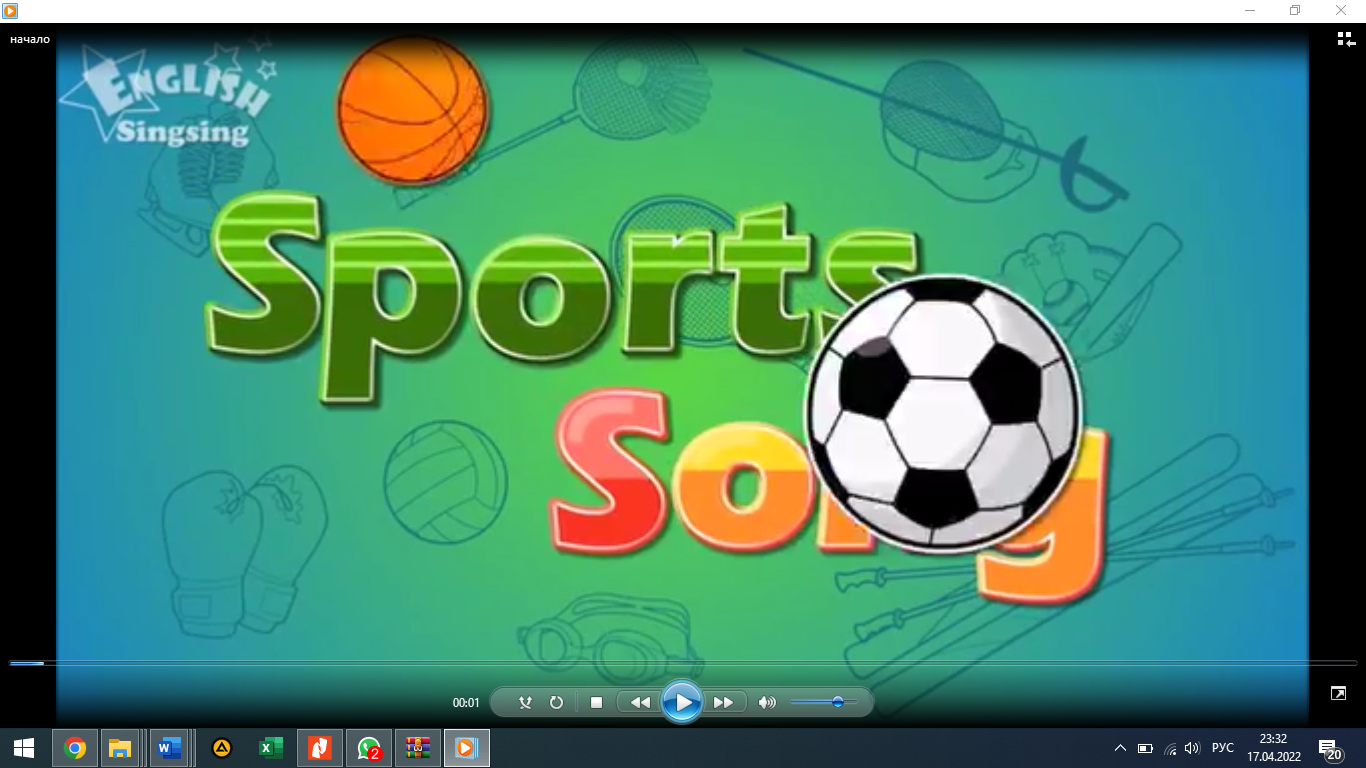
What is this video about?
Yes, right you are! This video is about sport and kinds of sport! So today we will speak about it.
So, find the sport which you watched in this video. (Soccer, baseball, basketball, volleyball, diving, swimming, skiing, skating, tennis, badminton, fencing, boxing).
Right you are!
So, can you play soccer? Can you play baseball? Can you swim? Can you dive? And so on.
Yes, I can. / No, I can’t.
What is your favourite sport? – My favourite sport is ….
Good for you!
Answer the questions
Watch a video about sport
Find the words
Answer the questions
Individual avaluation
Questions
Video
Objectives
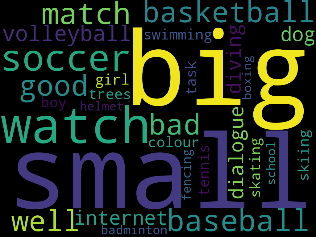
Questions
Middle
35min
Now we do some exercises! First let’s review words DO, GO, PLAY. When do we use these words?



|
Badminton |
|
Water polo |
|
Rugby |
|
Football |
|
Basketball |
|
Cricket |
|
Hockey |
|
Tennis |
|
Swimming |
|
Cycling |
|
Gymnastic |
|
Karate |
|
Baseball |
|
Golf |
|
Ice skating |
|
Judo |
DO – gymnastic, karate, judo.
GO – swimming, cycling, ice skating.
PLAY – badminton, water polo, rugby, football, basketball, cricket, hockey, tennis, baseball, golf.
Well done, boys and girls! Next task is on the cards. I give you cards with a table; you should ask your neighbor – How often do you…
I give you 2 minutes.
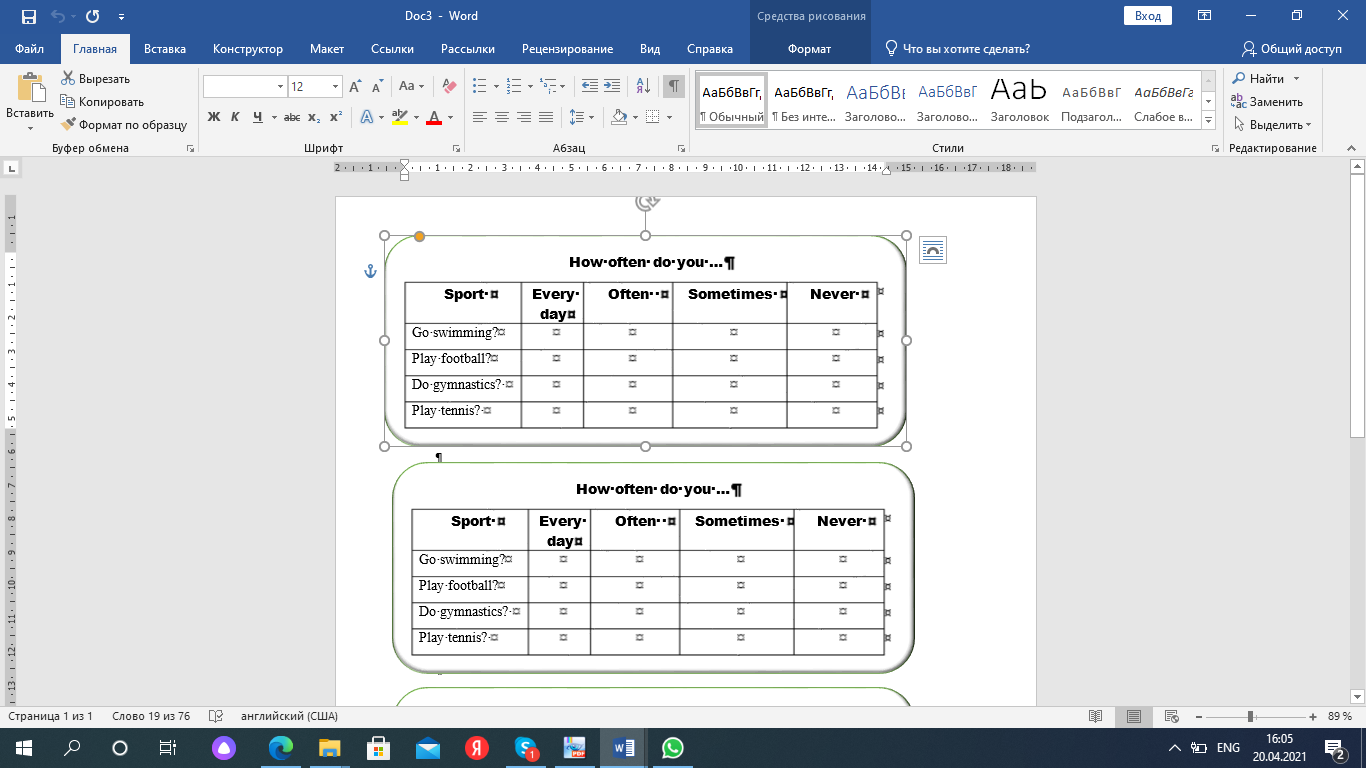
So , now I want to listen to you! Ask please your neighbor and answer the questions. (2 questions).
Well done! Thanks!
Let’s play! Name please these pictures! Good!
Find please the right picture. Who quickly?
|
|
|
|
|
|
|
|
|
|
|
|
|
|
|
|
|
|
|
|
Good!
Look at the blackboard. There are some pictures with riddles. Well let’s solve them!
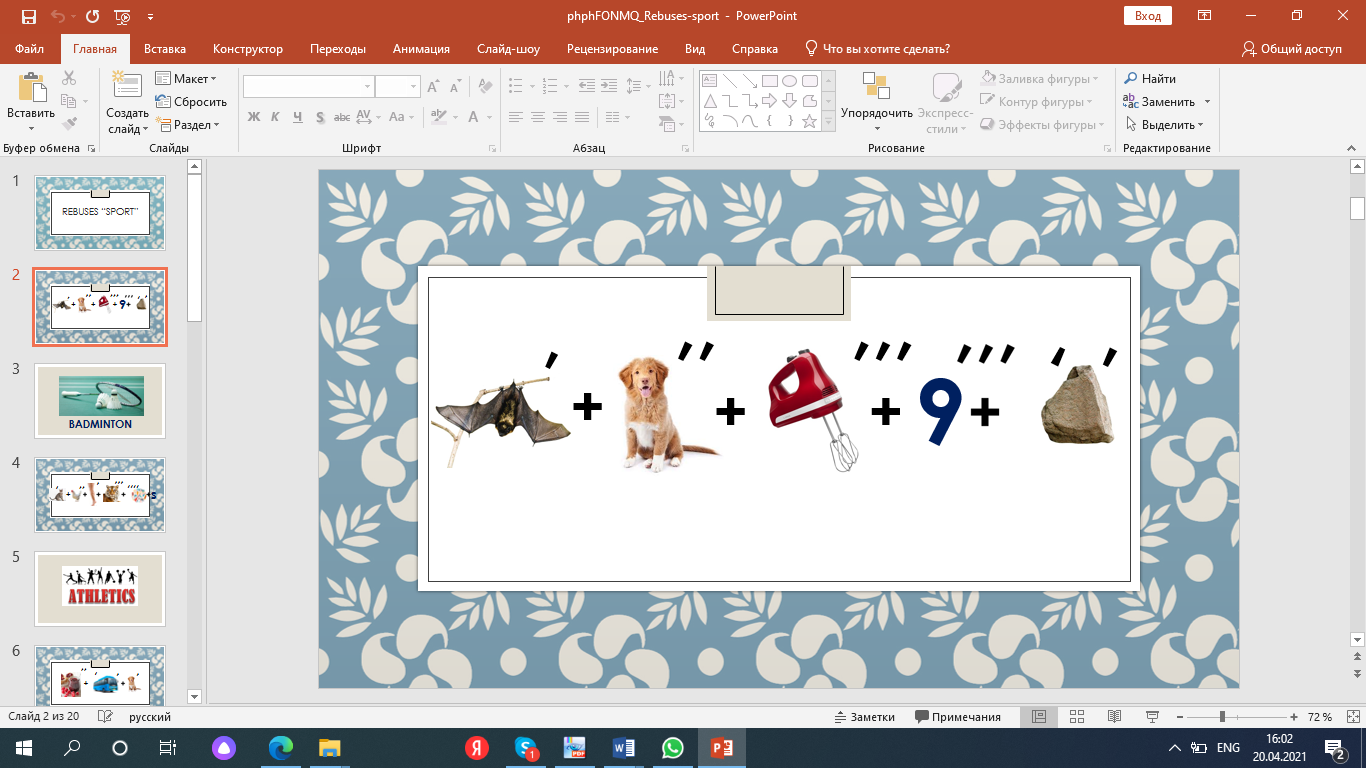
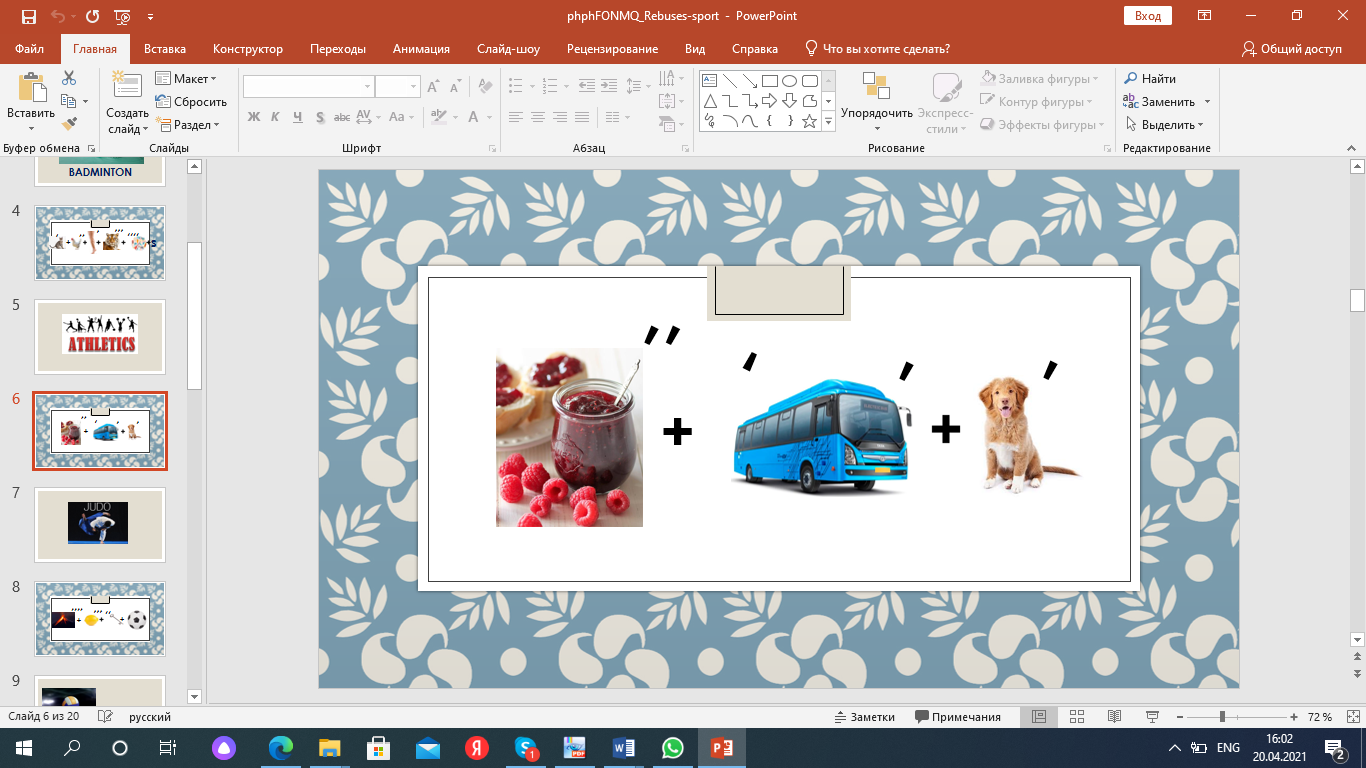

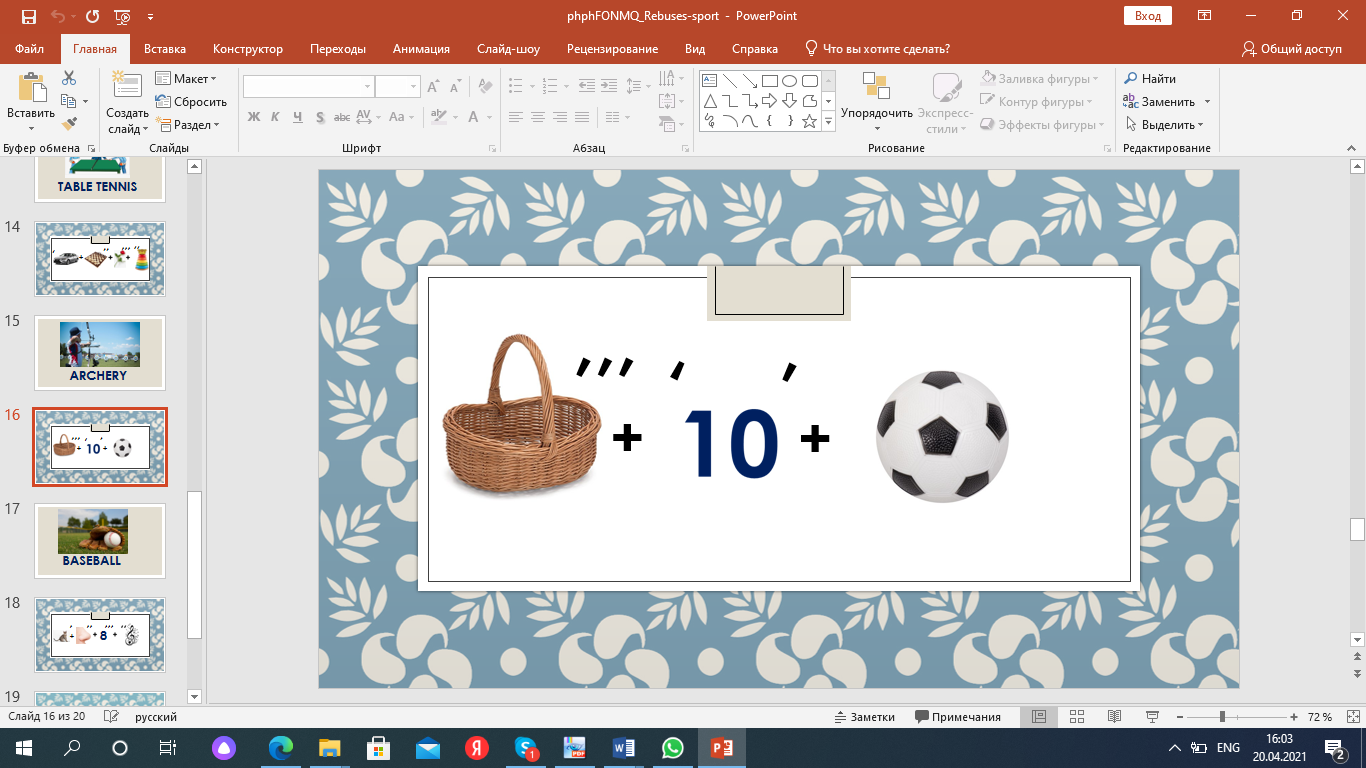
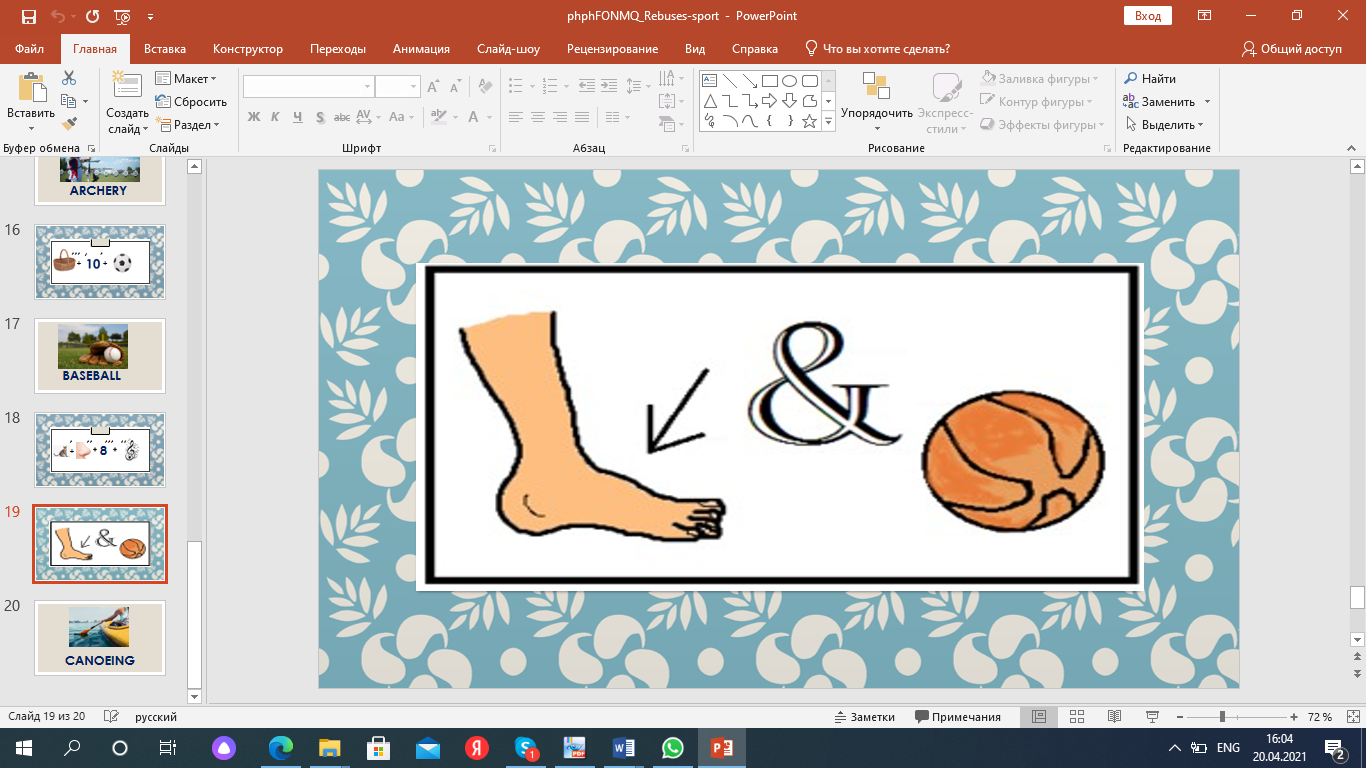
Write you are! Now I give you some cards with the words, you should read them, try to understand and complete the sentences? using the words from riddles and the phrase “We need …”
-
We need a ball and trainers to play football.
-
We need a racket to play badminton.
-
We need a bike and a helmet to go cycling.
-
We need a ball and a basket to play basketball.
-
We need a kimono to do judo.
|
1 |
a ball |
to play |
we |
trainers |
need |
football. |
and |
||
|
2. |
a racket |
we |
to play |
badminton. |
need |
||||
|
3. |
need |
and |
to go |
a bike |
we |
a helmet |
cycling. |
||
|
4. |
a ball |
a basket |
we |
and |
basketball. |
need |
to play |
||
|
5. |
a kimono |
need |
judo. |
we |
to do |
||||
Let’s check your task! Very good!
Well one more exercise. We need telephones.
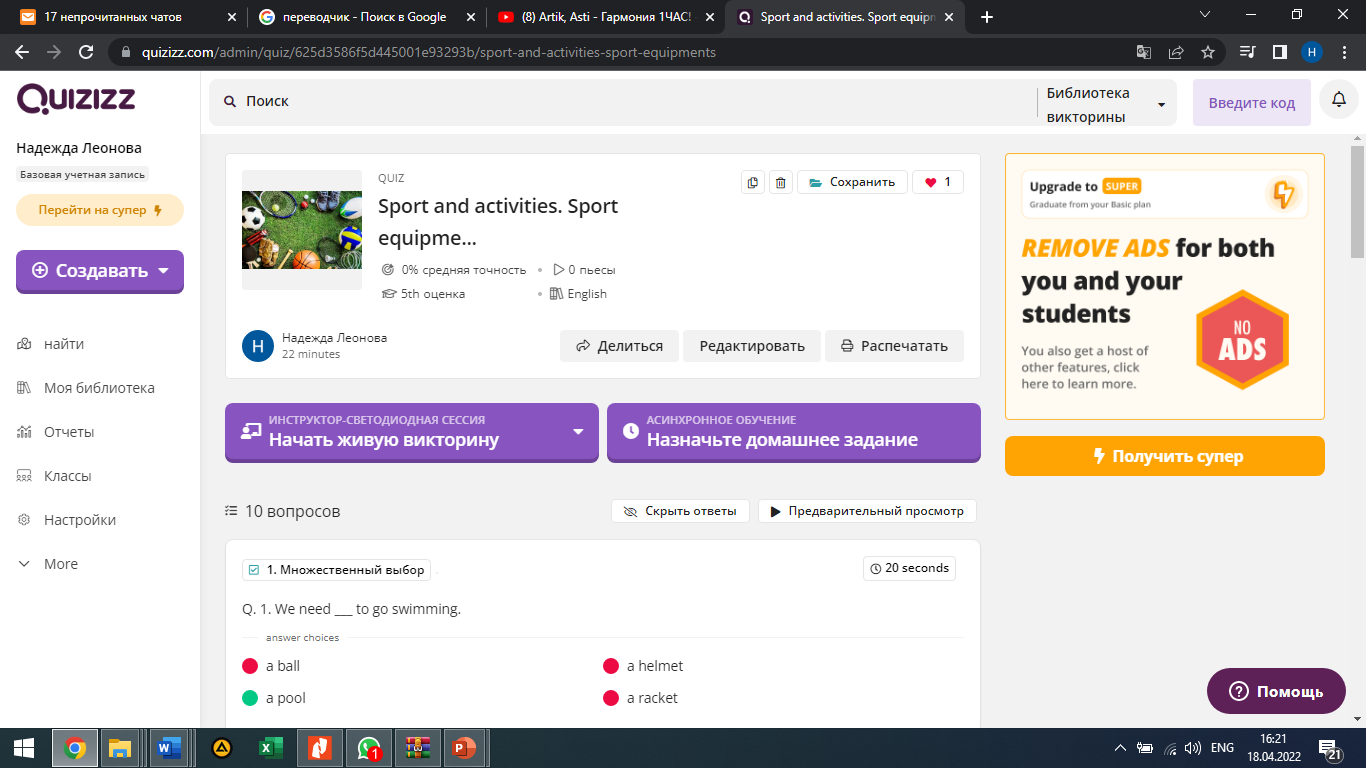
Students explain the rules
Match the words
Ask and answer the questions
Play. Find the pictures.
Match the words
Solve the riddle
Complete the sentences
Do tasks in Quizizz
Individual avaluation
Verbal evaluation
Mutual avaluation
Individual avaluation
Individual avaluation
Individual avaluation
Verbal evaluation
Baskets and cards with words about sport
Cards
Pictures with sports
Hammers (toys)
Cards
Blackboard
Presentation
Cards with task
Tables
Telephones
https://quizizz.com/admin/quiz/625d3586f5d445001e93293b/sport-and-activities-sport-equipments
Date:
12-09-2018
Teacher’s
name: Yerkin
Sadenov
Grade:
5
Number
present: 13
Absent:
1
Learning
objectives(s) that this lesson is contributing to
5.C 9. use imagination to express thoughts,
ideas, experiences and feelings
5.L 3. understand the main points of short,
supported talk on an increasing range of general and some curricular topics
5.R1. recognize, identify and sound with support a growing range of
language at text level
5.S 6. pronounce an increasing range of words,
short phrases and simple sentences intelligible
5.W1. plan, write,
edit work at text level with some support on a growing range of general and
curricular topics
5.
UE11. there is/ are statement, negative, question forms
including short and full answers and contractions
5. UE14. use prepositions of place: in, on,
under, behind, between, in front of, near, next to, opposite, on
the right/left
Lesson
objectives
All
learners will be able to:
—
Ask
and answer questions related to the topic with support
—
Use there is/there are with prepositions of place with support
—
Use new words in their speech with support
Most learners
will be able to:
— Ask and
answer questions related to the topic with some support
— Use there
is/there are with prepositions of place with some support
— Use new words
in their speech with some support
Some
learners will be able to:
—
Ask and answer questions related to the topic without support
—
Use there is/there are with prepositions of place without support
—
Use new words in their speech without support
Success
criteria
Students
will succeed in this class if they can:
1.follow
the instructions of a teacher
2.use
there is/there are and prepositions of place: in,
on,
under, behind, between, in front of, near, next to, opposite, on
the right/left
3.plan,
write, edit work at text level with some support on a growing range of
general and curricular topics
4.
describe their flat or house
Value
links
Respect,
cooperation, support, strong bond, сooziness and warmth
Cross
curricular links
Kazakh
and Russian languages
Previous
learning
Revision
Plan
Planned
timings
Planned
activities (replace the notes below with your planned activities)
Resources
Start
5
min
2 min
2 min
I. Class
organization ( greeting, asking the date and day, checking absentees)
Creating
favorable psychological condition:
students
stand in a circle and say to their neighbor a wish or a compliment.
II.
Revision previous lessons’ material with help of method: “Look, think and
find”
T:
Let’s review some words and sounds which connected with our topic. There are
some sounds on the blackboard. Teacher gives cards with words, students have
to find those sounds from the words and match them to the sounds on the
blackboard.
[ei]
[e] [u:] [i]
Table,
radio, case, desk, bed, shelf, room, roof, spoon, mirror, window, kitchen.
Dividing
students into 2 groups by the sounds:
1st group – students who
have chosen sounds [ei], [e] make the 1st group
2nd
group – students who have chosen sounds [u:[, [i] make the 2nd
group
slide,
flashcards
Middle
Min
25
4
min
3
min
3
min
4
min
6
min
7
min
End
2
min
3
min
2
min
5
min
III.
Brainstorming
by watching the video about unusual buildings,
students
guess the theme of the lesson.
T: What can you
say about this video? What kind of buildings are there in this video?
S1: I think it’s
an interesting video
S2: I think this
video is about houses
S3: I think this
video is about strange and unusual houses.
T: Yes, you are
right. Well done! The theme of our lesson is “Home and away”.
Now
children, let’s start our lesson with making association for the word “home”.
You must write what words are connected with the word “home”
a
study a living
room
a bathroom

a kitchen
a dining room
IV. Work on active vocabulary
T: Look at this
picture. What kind of rooms are there? There are some new words for you. You
have to find their translation on your own language. (Ex 5.from the SB)
a) Matching the rooms to the pictures.
b)
Reading
the words and trying to find their translation
poster— плакат/плакат
wardrobe— шкаф/шкаф
bookcase— кітап сөресі/книжная полка
bath— ванна/ванна
mirror— айна/зеркало
stairs— баспалдақ/ лестница
curtains— перделер/ занавески
cushions— диванның жастықшалары/ диванная подушка
sofa— диван/диван
pillows— жастықтар/подушки
desk— жазу үстелі/ письменный стол
carpet- кілем/ковер
armchair- кресло
fridge— мұздатқыш/холодильник
table— үстел/стол
chair- орындық/ стул
cooker- плита/плита
sink— қол,ыдыс жуатын жер/ раковина
painting— сурет/картина
They
will be assessed by “Applaud” method
T:
Open your vocabulary and write down these words
V. Explaining the grammar material:
T: At this lesson
we will get acquainted with the grammar structure there is/are with
the prepositions of place according to the topic.
Speaking.
Individual work.
Describing
classroom using grammar material.
Each
student gives one example using there is/are with the prepositions of
place
P1:
There is a clock on the wall
P2:
There is a picture over the blackboard
P3:
There are three bookcases on the left of the window
P4:
There are fifteen desks in the classroom
Writing. Look at the picture for a minute. Close your
books. Group the words in the picture under these headings. Compare with your
partner.(ex.6 from the SB)
Bedroom Living room Bathroom Kitchen
Assessing by using the shapers
Pair work method “Think-pair-share”
Writing
Exercise 2 on page 12( from the SB)
1 A: Is there a bookcase in the living room?
B: Yes, there is.
2 A: ……………… any books in the bookcase?
B: …………………………………………………….
3 A: ……………….. any cushions on the sofa?
B: …………………………………………………….
4 A: ……………………… a carpet on the floor?
B: …………………………………………………….
5 A: ………………. any curtains in front of the
windows?
B: …………………………………………………….
6 A: ………….. any chairs in the living room?
Assessing by showing thumb
Watching the video “Unusual buildings” and reading the text by
learners, then find out the unknown words from the text (ex.1
on p.10)
Check these words::;
• unusual • building • fan
• office • shape • violin
• lift • floor • dream home
• four-storey • great view
• outside • metal • inside
• wood • cool • summer
• warm • winter • crazy
Assessing by giving smiles
Group
work. Method “Jigsaw”
Group
1: Read the text A and explain its meaning to the 2nd group
Group
2: Read the text B and explain its meaning to the 1stgroup
Students
assess each other by “Traffic lights”
Red
– the topic hasn’t been developed
Yellow
– the answer is not clear
Green
– the topic is sufficiently covered
Making
a poster
Jan’s house
The piano house
The
piano house
Assessing by “ Two stars and
a wish”

Self assessment
by using a descriptor
Name____________________
|
№ |
Criteria |
Score+,— |
|
1 |
Use new words Poster, wardrobe, bookcase, sofa, pillows, desk, carpet, armchair, fridge, table, chair, painting, sink, cooker |
|
|
2 |
Ask 1. 2. 3. |
|
|
3 |
Make 1. 2. |
Evaluation sheet is given to all learners to fill in
and all sheets should be collected for teachers’ reflection and further work
on shortages.
Feedback:
Method
“Remembering through visualization”.
Complete
the chart
https://www.youtube.com/watch?v=X9HzpvydnxE
Active
board
Active
board, flashcards
grammar
table
www.grammar.cl/rules/prepositions-of-place.htm
www.grammar.cl/Present/ThereIsThereAre.htm
pictures
cards
worksheets
worksheets
traffic
light
Posters
markers
Worksheets
https://www.youtube.com/watch?v=qsmlxP8T720
Markers
2
min
Homework: to write an essay
“My ideal house/flat”
Reflection
Reflexive method “House”- on the
image of the house it is necessary to attach stickers-bricks, with comments
where students must write how clear was the material in the lesson and how
productive was the lesson for the students. 
Dear pupils! : Our today`s lesson is over. Today we have talked about “House”. You know, that house isn’t
only our living place, it’s the place that gives us warm. There is no
place, like home. You all worked very well, you were active, brilliant and
bright, thanks a lot. I want to
finish my lesson with the proverb: “East or West, Home is best”. Lesson is
over. Good bye!
Реклама
stickers
Additional
information
Differentiation
– how do you plan to give more support? How do you plan to challenge the more
able learners?
Assessment
– how are you planning to check learners’ learning?
Cross-curricular
links
Health
and safety check
ICT
links
Values
links
To
accommodate different learners in a single classroom considering their needs
and interests
To
foster high level of participation and language use through group and pair
works
Constantly
assess learners by feedback to develop their progress and identify next steps
in learning process for each learner
Self
assessment by using a descriptor
Students
are able to work with Power Point.
The
activity of students in group and pair works.
Reflection
Were
the lesson objectives/learning objectives realistic?
What
did the learners learn today?
What
was the learning atmosphere like?
Did
my planned differentiation work well?
Did
I stick to timings? What changes did I make from my plan and why?
Use
the space below to reflect on your lesson. Answer the most relevant questions
from the box on the left about your lesson.
Summary
evaluation
What
two things went really well (consider both teaching and learning)?
1:
2:
What
two things would have improved the lesson (consider both teaching and
learning)?
1:
2:
What
have I learned from this lesson about the class or individuals that will
inform my next lesson?
Short term plan
| Unit 1 Homes and away
Unit of a long term plan unit1 |
School: | |||||||
| Date: | Teacher name: | |||||||
| CLASS: 5 | Number present: | absent: | ||||||
| Lesson title | Homes 1 | |||||||
| Learning objectives(s) that this lesson is contributing to (link to the Subject programme) | L1. Understanding sequence of supported classroom instructions
S7. Use appropriate subject- specific vocabulary and syntax to talk about a limited range of general topics UE3. Use a growing variety of adjectives and regular and irregular comparative and superlative adjectives an a limited range of familiar general and curricular topics W3 write with support factual descriptions at text level which describe people, places and objects |
|||||||
| Lesson objectives | All learners will be able to:
Name parts of yurt, understand vocabulary, describe places Most of learners will be able to: Understand specific vocabulary |
|||||||
| Assessment criteria | Say topic words with clear pronunciation. Say expressions clearly
describe places and objects use adjectives in degrees |
|||||||
| Language objective |
Yurt , shanyrak uwyk a carcass |
|||||||
|
Values links |
To keep ,to increase and to hand down traditions and friendship between people | |||||||
| Cross-curricular links | art | |||||||
| Previous learning | Review | |||||||
| Plan | ||||||||
| Planned timings | Planned activities (replace the notes below with your 9planned activities) | Resources | ||||||
| Start | Greetings,
Good morning pupils! Who is on duty today? Who is absent? Teacher divides pupils in 2 groups with cards: “ Yurts’, “ Homes” |
|||||||
| Middle | L1 Task 1 Listen to and repeat attentively after teacher : a bedroom, a dining room, bathroom, a living room, a toilet, a study,
a round-shaped , a shanyrak , a kerege ,a uwyk L 1 Task 2 Match the pictures with the words Yurt is a round-shaped, it consists of three main parts and many other smaller parts. Three main Yurt usually does not have rooms in it, and it was a common practice to have a separate Task 2 Find out which of these adjectives in positive degree, in comparative degree, in superlative degree 1 A building is bigger than yurt. 2. Yurt is smaller than a building. 3. A house is modern. 4. A living room is the most comfortable room in the house. 5.Yurt is the oldest house. Descriptor: Learners find degrees of adjectives W3 Task 4 Write things you remember from the texts Yurt, kerege ,house ,shanurak .small ,beautiful ,modern Bedroom, living-room ,comfortable Descriptor: Pupils write names of rooms ,describe of house |
|||||||
| End | Answer the question “ How can be a modern house?” | |||||||
| Additional information | ||||||||
| Differentiation – how do you plan to give more support? How do you plan to challenge the more able learners? | Assessment – how are you planning to check learners’ learning? | Health and safety check | ||||||
| Differentiation can be achieved through the selection of activities, identification olearning outcomes for a certain student, provision of individual support to learners, selection of learning materials and resources based on the individual abilities of leaners (Theory of Multiple Intelligences by Gardner). | Use this section to record the techniques that you will use to assess what the learners have learned during the lesson. | Health saving technologies.
Using physical exercises and active activities. Rules from the Safety Rules book which can be applied in this lesson. |
||||||
| Reflection
Were the lesson objectives/learning objectives realistic? Did all the learners achieve the lesson objectives/ learning objectives? If not, why? Did my planned differentiation work well? Did I stick to timings? What changes did I make from my plan and why? |
Use the space below to reflect on your lesson. Answer the most relevant questions from the box on the left about your lesson. | |||||||
| Summary evaluation
What two things went really well (consider both teaching and learning)? 1: 2: What two things would have improved the lesson (consider both teaching and learning)? 1: 2: What have I learned from this lesson about the class or individuals that will inform my next lesson? |
||||||||
Short term plan
| Unit of a long term plan Unit 1 | School: B.Momyshuly | |||||||||||||||||||||||||||||||||||||||||||||||||||||
| Date: | Teacher name: Akhmetova A | |||||||||||||||||||||||||||||||||||||||||||||||||||||
| CLASS: 5 | Number present: | absent: | ||||||||||||||||||||||||||||||||||||||||||||||||||||
| Lesson title | Homes 2 | |||||||||||||||||||||||||||||||||||||||||||||||||||||
| Learning objectives(s) that this lesson is contributing to (link to the Subject programme) | S1. Provide basic information about themselves and others at sentence level on an increasing range of general topics.
S4. Respond with limited flexibility at sentence level to unexpected comments on an increasing range of general and curricular topics. W1. Plan, write, edit and proofread work at text level with support on a limited range of general and curricular topics. UE14. Use prepositions to talk about and location: use prepositions like to describe things and about to denote topics: use prepositions of direction to, into, out of, from, towards on a limited range of familiar general and curriculum topics. |
|||||||||||||||||||||||||||||||||||||||||||||||||||||
| Lesson objectives | All learners will be able to:
— Understand specific information related to the target. — Pronounce and name some words, according to the topic. — Recognize the theme and grammar material; Most learners will be able to: — To write short sentences in a paragraph. — Answer the questions. — Do exercises with grammar material; Some learners will be able to: — Use prepositions to make sentences. — Speak about things in a room. |
|||||||||||||||||||||||||||||||||||||||||||||||||||||
| Assessment criteria | To ask simple questions to get information about rooms
To develop the learners’ correct pronunciation of active vocabulary To put prepositions of directions in right order. To write and complete the sentences by putting names of the room |
|||||||||||||||||||||||||||||||||||||||||||||||||||||
| Values links | To respect each others opinion, to awake of their patriotic senses. To teach pupil to love our motherland. | |||||||||||||||||||||||||||||||||||||||||||||||||||||
| Cross-curricular
Links |
Kazakh and Russian | |||||||||||||||||||||||||||||||||||||||||||||||||||||
| Previous learning | Learners have an information about rooms. New vocabulary according to the previous lesson. Define comparative and superlative adjectives.
Can compare yurts with modern houses. |
|||||||||||||||||||||||||||||||||||||||||||||||||||||
| Plan | ||||||||||||||||||||||||||||||||||||||||||||||||||||||
| Planned timings | Planned activities (replace the notes below with your planned activities) | Resources | ||||||||||||||||||||||||||||||||||||||||||||||||||||
| Start | I. Greeting. Teacher greets learners; learners respond to greeting and take their places.
II. Happiness circle. Teacher greets and invites to stand in a circle and to greet each other. The teacher divided the class with the method of mosaic. III. S1 Brainstorming. Revision the previous lesson. Scrambled letters. You must make up some words and translate them into Kazakh. |
Flashcards
PPT (slide – 1-2) Pictures |
||||||||||||||||||||||||||||||||||||||||||||||||||||
| Middle | IV.S4. Working with new vocabulary.
Prepositions:
IV. UE14. Task 1. Practice Use prepositions. Complete the description of Sadie’s room. The bed’s on the left and there’s small wardrobe on the right. There are some posters …… the wall …… the bed. There is a table …… the bed, and there is a lamp and clock …… the table. There is a chest of drawers …… the table, and there are some shelves …… the chest of drawers. There is a desk …… the door, …… the window. There is a chair in the corner and another chair ….. the desk. You can see Sadie’s tennis racket …… the desk. Descriptor A learner: — Works cooperatively in a group; — Read the clause and put the precedent in the appropriate places.V. S4. 1 Task 2. Group work Read the puzzles and guess what rooms they are. I — group II — group Descriptor A learner: — Read and translate — Define rooms and furniture’s — Answer the questions W1. Task 3. Complete the sentences: Descriptor A learner: — Read and translate — Filling in the gaps |
PPT (slide – 3) Student’s book, Picture, dictionaries PPT (slide – 4) PPT (slide – 5) PPT (slide – 6) |
||||||||||||||||||||||||||||||||||||||||||||||||||||
| End | Assessment. Traffic light.
Feedback. The teacher gives comments about learners work and awards learner. Students will choose one and put on the board their stickers. Home task: Writing and speaking “My room” Use what you know Draw your room and furniture’s in the paper. Make a dialogue with your partner about your room. |
Stickers
PPT (slide – 7) |
||||||||||||||||||||||||||||||||||||||||||||||||||||
| Additional information | ||||||||||||||||||||||||||||||||||||||||||||||||||||||
| Differentiation – how do you plan to give more support? How do you plan to challenge the more able learners? | Assessment – how are you planning to check learners’ learning?
\\\ |
Health and safety check | ||||||||||||||||||||||||||||||||||||||||||||||||||||
| Task –completing the description
All learners will understand specific information related to the target, pronounce and name some words, according to the topic. Most learners will answer the questions, do exercises with grammar material; Some learners will use prepositions to make sentences. Speak about things in a room |
I will assess the learners works by praise orally and will give pictures for active pupils. | To pay attentions to learners safety during the doing activates, be careful in moving to places, in dividing to groups | ||||||||||||||||||||||||||||||||||||||||||||||||||||
| Reflection
Were the lesson objectives/learning objectives realistic? Did all the learners achieve the lesson objectives/ learning objectives? If not, why? Did my planned differentiation work well? Did I stick to timings? What changes did I make from my plan and why? |
Use the space below to reflect on your lesson. Answer the most relevant questions from the box on the left about your lesson.
Use prepositions like to describe things and about to denote topics: use prepositions of direction to, into, out of, from, towards on a limited range of familiar general and curriculum topics. All learners achieve the lesson objectives and learning objectives. |
|||||||||||||||||||||||||||||||||||||||||||||||||||||
| The lesson was exciting. The atmosphere was very positive. | ||||||||||||||||||||||||||||||||||||||||||||||||||||||
| Summary evaluation
What two things went really well (consider both teaching and learning)? 1: Group work. 2: The method “Mosaic” What two things would have improved the lesson (consider both teaching and learning)? 1: Some interesting facts. 2: Be more active students What have I learned from this lesson about the class orindividuals that will inform my next lesson? Today’s lesson was very interesting for me. The students were very active and very well done work with new material. They well prepared homework and well learnt a new lesson because all my questions, could make short sentences for new words. But I think the listening was difficult for students. I will consider it my next lesson. |
||||||||||||||||||||||||||||||||||||||||||||||||||||||
Short term plan
| Unit of a long term plan | School: | ||||||
| Date: | Teacher name: | ||||||
| CLASS: 5 | Number present: | absent: | |||||
| Lesson title | Homes 2 | ||||||
| Learning objectives(s) that this lesson is contributing to (link to the Subject programme) | 5.S6 communicate meaning clearly at sentence level during, pair, group and whole class exchanges
5.S7 and use appropriate subject-specific vocabulary syntax to talk about a limited range of general topics 5.W3 write with support factual descriptions at text level which describe people, places and objects 5. UE6 use basic personal and demonstrative pronouns and quantitative pronouns some, any, something, nothing anything on a limited range of familiar general and curricular topics |
||||||
| Lesson objectives | All learners will be able to: ask simple questions to get information and answer it use appropriate subject-specific vocabulary syntax to talk about
Most learners will be able to: write with support factual descriptions use prepositions to talk about location Some learners will be able to: communicate meaning clearly at sentence level during, pair, group and whole class exchanges organise and present information |
||||||
| Assessment criteria | Ask and answer the questions using subject specific vocabulary
Describe your room with the given objects fill in the correct pronouns and quantitative pronouns some, any, something, nothing anything Describe the given home |
||||||
| Language objective | Bedroom, living room, bathroom, kitchen, dining room, upstairs and downstairs, sofa, bed, TV, armchair, table, chair, carpet, curtain. | ||||||
| Values links | National unity and peace and harmony in our society to teach learners to love their home and protect it. | ||||||
| Cross-curricular links | Kazakh, Russian languages | ||||||
| Previous learning | Homes (bedroom, bathroom, living room, kitchen)
They know all the objects belonging to the house and vocabulary They introduced with the construction there is / there are |
||||||
| Plan | |||||||
| Planned timings | Planned activities (replace the notes below with your planned activities) | Resources | |||||
| Start
10min |
T-S.Greetings: Good afternoon dear children
How are you? What is the weather like today? Is it hot or warm? Is it rainy or sunny? What is the weekday today? What is the season now? Org moment: T-S. Dividing learners into three groups by the names of rooms Livingroom bathroom kitchen T-S .After dividing each groups should tell about the rooms and describe it what they can do in that room. Checking homework: “Moving questions” This is the activity for asking homework all of you stand up make a circle and round the rope and stop there are sticker on the rope with the given questions according to the previous lesson take a sticker opposite of you and answer the questions. 1) What do we do in the living room? 2) What mother does in the kitchen? 3) Where do we sleep? 4) Where do we wash our face? 5) How many rooms are there in your house? T. Introducing the lesson objectives. Today we are going to talk about our homes and objects in it and will describe and talk about it. T-S. Teacher will put some questions according to the theme. Why should we need a home? Do we need rooms? What would we do if we have no rooms? Learners will answer to the given questions. |
Cards flashcards of rooms A rope with stickers |
|||||
| Middle
30min |
Task-1.
W3. Describe your house with the given vocabulary Bedroom, living room, bathroom, kitchen, dining room, upstairs and downstairs, sofa, bed, TV, armchair, table, chair, carpet, curtain. Draw your ideal bedroom. In three minutes write a few sentences about it. Compare your room with your partner’s. What is similar/different? Tell the class My ideal bedroom has got … . There’s a … in my bedroom. …There is a ………. My bedroom is cool! Descriptor: Describe your house with the given vocabulary UE6. In general we use some in positive sentences and any in questions and negative sentences .We also use any with the meaning ‘it doesn’t matter which’: • You can catch any bus. They all go to the centre. Task-2. UE6Complete the sentences with some or any. 1 .We didn’t buy …any… flowers. 2 .This evening I’m going out with……………………….. friends of mine. 3.‘Have you seen……………………….. good films recently?’ ‘No, I haven’t been to the cinema for ages.’ 4. I didn’t have money, so I had to borrow……………………….. 5 .Can I have……………………….milk in my coffee, please? 6 .I was too tired to d o ……………………….work. 2)B. Make up your own sentences with the some ,any There is a nothing between two beds 3) C. Describe your room with the some ,any There is some flowers in the kitchen. Descriptor:fill in the correct pronouns Make up sentences using given pronouns Describe one room using pronouns Task-3 S6. Say the suitable sentences in pair work two learners in pair should say three sentences two sentences must be according to the theme one sentence must be the odd one and neighbours should recognize which is the odd one out. Living room is the place where we can sit and watch TV. Kitchen is the place where we can cook meals. Gym is the place where we can play volleyball with our friends Descriptor: give two clear sentences and one odd sentence during pair work Task-4 S7. Complete the grapes with the given vocabulary and talk about it. Bedroom, living room, bathroom, kitchen, dining room S-S. For the conclusion of the lesson teacher takes the activity “branches of grapes” there will be drawn branch of grapes and learners should put the names of rooms on the grapes and pronouns which relates to a house on branches learners will show and discuss about rooms and describe one room of their house using pronouns. Descriptor: Complete the grapes with the given vocabulary and describe one room of your house. |
A cheet of paper pencil
pictures of preposition cards Flipchart marker cards A list of descriptor Flipchart |
|||||
| End
5min |
For the feedback we will talk about “Traffic lights”
-Green The lesson is clear for me -Yellow I have got some question -Red I don’t understand anything Home work: Make up a story about your friend’s house using prepositions |
Figures of traffic lights | |||||
| Additional information | |||||||
| Differentiation – how do you plan to give more support? How do you plan to challenge the more able learners? | Assessment – how are you planning to check learners’ learning? | Health and safety check | |||||
| Differentiation can be achieved through the selection of activities, identification of learning outcomes for a certain student, provision of individual support to learners, selection of learning materials and resources based on the individual abilities of leaners (Theory of Multiple Intelligences by Gardner). | Teacher assesses learners achievements with formative assessment by gests and by traffic lights | Health saving technologies.
Using physical exercises and active activities. Rules from the Safety Rules book which can be applied in this lesson. |
|||||
| Reflection
Were the lesson objectives/learning objectives realistic? Did all the learners achieve the lesson objectives/ learning objectives? If not, why? Did my planned differentiation work well? Did I stick to timings? What changes did I make from my plan and why? |
Use the space below to reflect on your lesson. Answer the most relevant questions from the box on the left about your lesson. | ||||||
Short term plan
| Unit :1 HOME AWAY | School: | ||||||||||||||||||||||||||||||||||||||||||||||||||||
| Date: | Teacher’s name: | ||||||||||||||||||||||||||||||||||||||||||||||||||||
| CLASS: 5 | Number present: | absent: | |||||||||||||||||||||||||||||||||||||||||||||||||||
| Lesson title | Cities and countries 1 | ||||||||||||||||||||||||||||||||||||||||||||||||||||
| Learning objectives(s) that this lesson is contributing to (link to the Subject programme) | 5.L1understand a sequence of supported classroom instructions
5.S1 provide basic information about themselves and others at sentence level on an increasing range of general topics 5.S2 ask simple questions to get information about a limited range of general topics 5. UE3 use a growing variety of adjectives and regular and irregular comparative and superlative adjectives on a limited range of familiar general and curricular topics |
||||||||||||||||||||||||||||||||||||||||||||||||||||
| Lesson objectives | All learners will be able to:understand a sequence of supported classroom instructions ask simple questions to get information
Most learners will be able to: use adjectives and regular and irregular comparative and superlative adjectives with support Some learners will be able to: provide basic information about themselves and others at sentence level on an increasing range of general topics |
||||||||||||||||||||||||||||||||||||||||||||||||||||
| Assessment criteria | understand specific information and ask information
use appropriate regular and irregular comparative and superlative adjectives write factual descriptions write an information about your city |
||||||||||||||||||||||||||||||||||||||||||||||||||||
| Language objective | the UK the USA Kazakhstan Turkey France Russia Italy Portugal Greece Mexico China Spain | ||||||||||||||||||||||||||||||||||||||||||||||||||||
| Values links | National unity and peace and harmony in our society to teach learners to love their home and protect it. | ||||||||||||||||||||||||||||||||||||||||||||||||||||
| Cross-curricular | Geography, country study | ||||||||||||||||||||||||||||||||||||||||||||||||||||
| Previous learning | Homes (dining room, hall, bedroom, bathroom, livingroom, kitchen)
Learners know all the names of rooms belonging to the house Learners introduced with the construction there is / there are and direction prepositions on,under, behind, next to, in front of , between |
||||||||||||||||||||||||||||||||||||||||||||||||||||
| Plan | |||||||||||||||||||||||||||||||||||||||||||||||||||||
| Planned timings | Planned activities (replace the notes below with your planned activities) | Resources | |||||||||||||||||||||||||||||||||||||||||||||||||||
| Start
5min |
Greeting: Good day, dear learners! Nice to meet you
How are you? Thank you, sit down. Are you ready for today’s lesson? Who is absent today? Who is on duty today? What is the weather like today? Checking home task: “Brainstorming”everyone takes a piece of paper and writes as many words as you remember from the theme homes. Share ideas asking each student to read out a word from their list. They must not repeat a word that has already been said. T-S. Dividing learners into two groups by “magic box” there will be some sweets choose one of them. Who choose red sweets sit to red group and who choose green sit to green group. T. Teacher plays a video a conversation between boy and a girl they talk about cities and countries and then learners recognize by this video the name of the new theme. T. Introducing the lesson objectives. Now boys and girls the theme of our new lesson is Cities and countries Today we are going to speak about the best places for living T-S. Teacher will put some questions according to the theme. Do you live in a city? What is the difference between city or a country? Where do we live? How do you think is the city better place to live? |
Sweets, box, board, video
The pictures of cities and the names of countries |
|||||||||||||||||||||||||||||||||||||||||||||||||||
| Middle
8min 8min 5min 6 min 10min |
Task 1.
L1.Listen to the recorder and complete the table with the capitals of countries and nationalities.
Descriptor: Complete the table. Presentation of the grammatical materials through “Bus stop”. The teacher presents materials as a guide in the bus. Each bus stop presents one city of the Kazakhstan. Bus stop 1 “Astana” Adjectives Bus stop 2 “Almaty” Bus stop 3 “Shymkent” Task -2 UE3. Learners change the words into the right form of adjectives Irregular Forms of Comparison
Task -3 UE3. Learners change the words into the right form of adjectives. Clean –cleaner – cleanest Easy — ______ — easiest Fat — ______ — fattest Hot — ______ — hottest ——— – simplier — _______ Thin – thinner — _________ Descriptor: — change the words into the right form of adjectives; — put the words in the right form of adjectives. Task-4 S2. “Ten question on stickers” One learner comes to the board and puts a sticker on forehead and learners will put question according the city and the country of a city For ex: What is the capital city of England? What is the country of Moscow city? Descriptor: Answer the questions S6. “Creative work” Make your own story about your city with the given vocabulary Bank, airport, museum, hospital, theatre, chemist’s ,library, bus stop, police station, police station I live in Astana city. There are a lot of banks……. Descriptor: Create a story using given vocabulary. |
CD, blanks Map of the world Pictures of cities Stickers posters markers |
|||||||||||||||||||||||||||||||||||||||||||||||||||
| End
3 min |
Reflection “Five fingers”
Which task did you like the most? What was easy for you? What was difficult for you? Show on your fingers your opinion about the lesson 1-the lesson was difficult 2-you liked the most 3- your mood glad, sad, bad 4- Activities you have done 5- I learnt today Reflection through “Five fingers” 1 finger – difficulties during the lesson 2 finger – what do you like during the lesson 3 finger – your mood 4 finger – what do you do today? 5 finger – what do you learn today? Learners draw the shape of their hands and write on each finger. Home work: Look for from internet and find information about language population capital the weather and best places of your favourite country. |
||||||||||||||||||||||||||||||||||||||||||||||||||||
| Additional information | |||||||||||||||||||||||||||||||||||||||||||||||||||||
| Differentiation – how do you plan to give more support? How do you plan to challenge the more able learners? | Assessment – how are you planning to check learners’ learning? | Health and safety check | |||||||||||||||||||||||||||||||||||||||||||||||||||
| More support will be given in the form of speaking prompts, gestures, and additional questions.
Challenge more able learners: — according to the video learners guess the theme of the lesson; — answer to the questions; — make own stories. |
In order to motivate learners after each their answer a teacher gives formative assessment by the
Sun-the best star -good cloud-need work. Reflection through “Five fingers” 1 finger – difficulties during the lesson 2 finger – what do you like during the lesson 3 finger – your mood 4 finger – what do you do today? 5 finger – what do you learn today? Learners draw the shape of their hands and write on each finger. |
During the lesson moving activities will be used. | |||||||||||||||||||||||||||||||||||||||||||||||||||
| Reflection
Were the lesson objectives/learning objectives realistic? Did all the learners achieve the lesson objectives/ learning objectives? If not, why? Did my planned differentiation work well? Did I stick to timings? What changes did I make from my plan and why? |
Use the space below to reflect on your lesson. Answer the most relevant questions from the box on the left about your lesson. | ||||||||||||||||||||||||||||||||||||||||||||||||||||
По теме: методические разработки, презентации и конспекты
Календарно-тематическое планирование «Технология модернизации электронно-вычислительных машин»
календарно-тематическое планирование…
Календарно-тематическое планирование по физике в 8 классе для электронного журнала. Перышкин А. В.
КТП по физике в 8 классе . По учебнику Перышкина А.В….
Календарно-тематическое планирование по физике в 9 классе для электронного журнала. Перышкин А.В.
КТП по физике в 9 классе по учебнику Перышкина А. В….
Календарно-тематическое планирование по физике в 10 классе для электронного журнала. Мякишев Г.Я.
КТП по физике в 10 классе. Мякишев Г. Я….
Календарно -тематическое планирование по физике в 11 классе для электронного журнала. Мякишев Г.Я.
КТП по физике в 11 классе….
Календарно-тематическое планирование по русскому языку 5 класса для электронного журнала — 170 часов (5 часов в неделю)
Данное КТП (в формате Excel) по русскому языку для 5 класса составлено на основе Федерально го государственного образовательного стандарта основ ного общего образования второго поколения, Примерной пр…
Календарно-тематическое планирование по русскому языку 6 класс для электронного журнала — 204 часа (6 часов в неделю)
Данное КТП составлено на основе рабочей программы по русскому языку для 6 класса на основе Федерально го государственного образовательного стандарта основ ного общего образования второго поколения.Уче…
Краткосрочные и среднесрочные планы английский язык по Т.Аяповой для 1 (smiles), 2,3,4,5,6,7,8,9,10,11 классов.
Планы подходят как для русских так и для казахских классов
Планы по новой программе на год (обновленка)
для 1,2,3,4,5,6,7,8,9,10,11 классов на 2022-2023 учебный год
| Английский язык КСП,КТП обновленка 1 класс | 4400 тг. |
| Английский язык КСП,КТП обновленка 2 класс | 4400 тг. |
| Английский язык КСП,КТП обновленка 3 класс | 4400 тг. |
| Английский язык КСП,КТП обновленка 4 класс | 4400 тг. |
| Английский язык КСП, КТП обновленка 5 класс Цена снижена так как комплект не полный, только 1 полугодие | 2000 тг. |
| Английский язык КСП, ДСП обновленка 6 класс | 4400 тг. |
| Английский язык КСП, КТП обновленка 7 класс | 4400 тг. |
| Английский язык КСП, КТП обновленка 8 класс | 4400 тг. |
| Английский язык КСП, КТП обновленка 9 класс | 4400 тг. |
| Английский язык КСП, КТП обновленка 10 класс | 4400 тг. |
| Английский язык КСП, КТП обновленка 11 класс | 4400 тг. |
| Полный комплект с 1 по 11 класс обновленка английский язык (со скидкой) | 34 000 тг. |
Жоспарлау бойынша жаңартылған бағдарлама
1,2,3,4,5,6,7,8,9,10,11 сынып орыс тілі және әдебиеті 2022-2023 оқу жылы

______________________________________________________________________

(Просьба не дублировать сообщения, мы отвечаем в течении 1-3 часов)
Материалдар / Excel book for 5 grade. module 5 .Lesson 1
2022-2023 оқу жылына арналған
қысқа мерзімді сабақ жоспарларын
жүктеп алғыңыз келеді ма?
ҚР Білім және Ғылым министірлігінің стандартымен 2022-2023 оқу жылына арналған 472-бұйрыққа сай жасалған
Материал туралы қысқаша түсінік
Қысқа мерзімді сабақ жоспары
Авторы:
Автор материалды ақылы түрде жариялады.
Сатылымнан түскен қаражат авторға автоматты түрде аударылады. Толығырақ
28 Желтоқсан 2019
3169
4 рет жүктелген
Бүгін алсаңыз
30% жеңілдік
беріледі
770 тг 539 тг
Бұл бетте материалдың қысқаша нұсқасы ұсынылған. Материалдың толық нұсқасын жүктеп алып, көруге болады
Text Centered
«Ustaz tilegi» Республикалық ғылыми – әдістемелік журналы министірліктің №KZ09VPY00029937 куәлігімен ресми тіркелген.
Бұл сертификат «Ustaz tilegi» Республикалық ғылыми – әдістемелік журналының желілік басылымына өз авторлық жұмысын жарияланғанын растайды. Журнал Қазақстан Республикасы Ақпарат және Қоғамдық даму министрлігінің №KZ09VPY00029937 куәлігін алған. Сондықтан аттестацияға жарамды.
Сайтта заңсыз жарияланған материалды көрсеңіз бізге хабарласыңыз. Редакцияның көзқарасы автордың көзқарасымен сәйкес келмеуі мүмкін.
Материал іздеу
Сіз үшін 400 000 ұстаздардың еңбегі мен тәжірибесін біріктіріп, ең үлкен материалдар базасын жасадық. Төменде пәніңізді белгілеп, керек материалды алып сабағыңызға қолдана аласыз
Барлығы 663 959 материал жиналған






